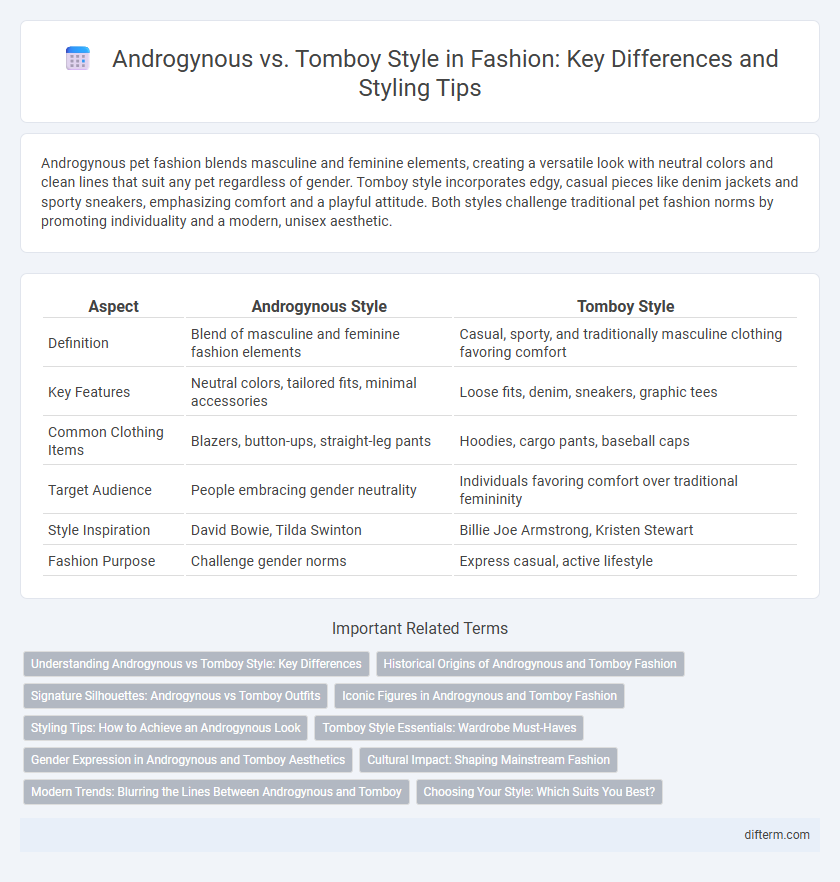Androgynous pet fashion blends masculine and feminine elements, creating a versatile look with neutral colors and clean lines that suit any pet regardless of gender. Tomboy style incorporates edgy, casual pieces like denim jackets and sporty sneakers, emphasizing comfort and a playful attitude. Both styles challenge traditional pet fashion norms by promoting individuality and a modern, unisex aesthetic.
Table of Comparison
| Aspect | Androgynous Style | Tomboy Style |
|---|---|---|
| Definition | Blend of masculine and feminine fashion elements | Casual, sporty, and traditionally masculine clothing favoring comfort |
| Key Features | Neutral colors, tailored fits, minimal accessories | Loose fits, denim, sneakers, graphic tees |
| Common Clothing Items | Blazers, button-ups, straight-leg pants | Hoodies, cargo pants, baseball caps |
| Target Audience | People embracing gender neutrality | Individuals favoring comfort over traditional femininity |
| Style Inspiration | David Bowie, Tilda Swinton | Billie Joe Armstrong, Kristen Stewart |
| Fashion Purpose | Challenge gender norms | Express casual, active lifestyle |
Understanding Androgynous vs Tomboy Style: Key Differences
Androgynous style blends traditionally masculine and feminine clothing elements to create a balanced, gender-neutral appearance, often characterized by tailored suits, minimalistic designs, and muted color palettes. Tomboy style emphasizes comfort and practicality with a casual, sporty vibe, incorporating items like loose-fitting jeans, graphic tees, and sneakers that align with a masculine influence. Understanding these styles highlights their core differences: androgynous fashion challenges gender norms with fluid silhouettes and refined details, while tomboy fashion adopts a more rugged, straightforward approach rooted in traditionally masculine casual wear.
Historical Origins of Androgynous and Tomboy Fashion
Androgynous fashion originated in the early 20th century as a rebellion against strict gender norms, popularized by icons like Marlene Dietrich and later David Bowie, blending masculine and feminine elements to create a gender-neutral aesthetic. Tomboy style traces back to the late 19th and early 20th centuries, emerging as young women adopted traditionally male clothing and behaviors to challenge societal expectations, emphasized by figures such as Amelia Bloomer and later reinforced during the 1920s flapper era. Both styles have evolved as cultural statements reflecting shifting attitudes towards gender identity and expression throughout fashion history.
Signature Silhouettes: Androgynous vs Tomboy Outfits
Signature silhouettes in androgynous fashion emphasize clean lines and balanced proportions, blending masculine and feminine elements through tailored blazers, straight-leg trousers, and minimalist shirts. Tomboy style features relaxed fits with oversized shirts, loose jeans, and casual outerwear that prioritize comfort and a laid-back aesthetic. Both styles challenge traditional gender norms but differ in structure, with androgynous leaning towards refined neutrality and tomboy embracing a more rugged, effortless vibe.
Iconic Figures in Androgynous and Tomboy Fashion
David Bowie and Tilda Swinton remain iconic figures in androgynous fashion, breaking traditional gender norms with their fluid and bold style choices. On the tomboy side, artists like Kristen Stewart and Cara Delevingne exemplify the effortless blend of masculine and feminine elements, combining tailored pieces with casual, rugged aesthetics. Both styles continue to influence contemporary fashion by challenging conventional gender-specific clothing and embracing individuality.
Styling Tips: How to Achieve an Androgynous Look
To achieve an androgynous look, focus on blending traditionally masculine and feminine pieces with neutral colors like black, white, and gray to create a balanced silhouette. Incorporate tailored blazers, slim-fit trousers, and structured button-down shirts while opting for minimal accessories and sleek hairstyles to maintain a clean, gender-neutral aesthetic. Experiment with layering and oversized fits to enhance the androgynous vibe without leaning heavily into either tomboyish or overtly feminine styles.
Tomboy Style Essentials: Wardrobe Must-Haves
Tomboy style essentials feature wardrobe staples such as tailored blazers, relaxed-fit jeans, and classic white sneakers that emphasize comfort and functionality while maintaining a chic, effortless vibe. Key pieces include oversized button-down shirts, leather jackets, and graphic tees, which create a versatile base for mixing casual and edgy elements. Incorporating minimalist accessories like simple watches and low-profile hats completes the tomboy look, balancing ruggedness with understated style.
Gender Expression in Androgynous and Tomboy Aesthetics
Androgynous and tomboy styles both challenge traditional gender norms by blending elements typically associated with masculinity and femininity, offering diverse expressions of identity. Androgynous aesthetics emphasize a seamless fusion of gendered clothing, often featuring neutral tones and tailored fits that obscure gender distinctions. Tomboy fashion, meanwhile, highlights a preference for casual, comfortable attire such as loose jeans, sneakers, and graphic tees, reflecting a more traditionally masculine approach to self-expression without entirely rejecting femininity.
Cultural Impact: Shaping Mainstream Fashion
Androgynous and tomboy styles have significantly influenced mainstream fashion by challenging traditional gender norms and promoting fluidity in clothing choices. Designers incorporate unisex silhouettes and neutral color palettes, reflecting a cultural shift towards inclusivity and self-expression. This transformation drives global fashion trends, encouraging brands to prioritize diversity and redefine beauty standards.
Modern Trends: Blurring the Lines Between Androgynous and Tomboy
Modern fashion trends increasingly blur the lines between androgynous and tomboy styles, emphasizing fluidity and self-expression over rigid gender norms. Both styles incorporate minimalist silhouettes, oversized fits, and neutral color palettes, appealing to individuals seeking comfort and versatility. Designers and streetwear influencers champion hybrid looks that merge traditionally masculine and feminine elements, reflecting a growing cultural shift towards gender inclusivity in fashion.
Choosing Your Style: Which Suits You Best?
Androgynous style blends traditionally masculine and feminine elements to create a balanced, gender-neutral look, often featuring tailored blazers, neutral tones, and minimalist accessories. Tomboy style emphasizes comfort and a casual, sporty vibe with loose-fitting jeans, graphic tees, and sneakers, reflecting a more relaxed, boyish aesthetic. Choosing between androgynous and tomboy depends on your comfort with gender expression, desired level of formality, and personal fashion goals.
androgynous vs tomboy style Infographic

 difterm.com
difterm.com